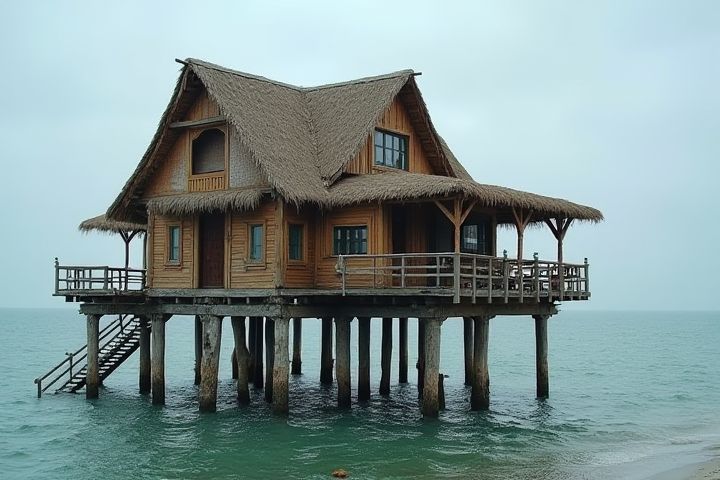
Houses built on stilts are primarily designed to protect against flooding, especially in low-lying areas or regions prone to heavy rainfall and storm surges. Elevating the structure helps prevent water damage to the foundation and interior, ensuring longevity and safety for occupants. Stilt construction also enhances ventilation and reduces humidity, creating a more comfortable living environment. Furthermore, these homes often provide additional storage or utility space beneath, maximizing usable square footage. In coastal areas, stilt homes can offer panoramic views of the surrounding landscape while blending harmoniously with the natural environment.
Why Are Houses Built On Stilts
Flood prevention
Houses built on stilts are primarily designed to prevent flood damage, elevating the structure above potential floodwaters. By raising the living space typically 1 to 10 feet above ground, these homes minimize the risk of water intrusion, significantly reducing repair costs and loss of belongings during severe weather events. In flood-prone areas, such as coastal regions or riverbanks, approximately 30% of homes utilize this design, demonstrating its effectiveness in safeguarding property. This architectural approach not only enhances safety but also complies with local building codes that require higher foundations in flood zones.
Avoiding pests
Houses built on stilts effectively mitigate pest infestations by elevating the structure above ground level, creating a barrier between the living space and the soil where pests like termites and rodents thrive. This elevation also aids in moisture control, as stagnant water can attract a variety of insects and create conducive conditions for their existence. Furthermore, the air circulation around the elevated foundation helps in reducing humidity, discouraging mold and attracting fewer pests. In regions prone to flooding, houses on stilts provide an added advantage by preventing water damage while keeping pests at bay.
Better ventilation
Houses built on stilts, often seen in flood-prone areas, promote better ventilation by elevating living spaces above ground level. This elevation allows for natural airflow, reducing humidity and improving indoor air quality, which is particularly beneficial in tropical climates. By utilizing the space under the house, the design creates a natural cooling effect as air circulates freely beneath the structure. As a result, homeowners can enjoy a more comfortable living environment while minimizing the need for artificial cooling systems and reducing energy consumption.
Scenic views
Houses built on stilts elevate living spaces, offering panoramic scenic views that enhance the surrounding environment. By raising the structure, homeowners can experience unobstructed vistas of landscapes, oceans, or mountains, creating a tranquil atmosphere. This design also contributes to flood prevention, ensuring safety and stability in areas prone to rising water levels. Enjoying a stilted home not only maximizes breathtaking views but also incorporates functional benefits that protect your investment.
Seismic stability
Houses built on stilts, particularly in earthquake-prone areas, significantly enhance seismic stability by elevating the structure above ground level. This elevation allows for increased absorption and dissipation of seismic forces, reducing the risk of damage during an earthquake. Elevating a home on stilts also minimizes the impact of ground shaking on the foundation, maintaining structural integrity. Selected materials and engineering designs further ensure that these elevated homes resist lateral forces that can cause catastrophic failure.
Cost-effective construction
Houses built on stilts offer significant cost-effective construction benefits, particularly in flood-prone areas where traditional foundations may be vulnerable. Installing elevated structures can reduce the need for costly flood insurance by minimizing the risk of water damage, potentially saving homeowners thousands of dollars over time. Furthermore, the use of lighter materials for stilted homes can lower overall building costs, as less concrete and reinforcement are necessary compared to standard foundations. Your choice of stilt construction also allows for better site drainage and can enhance the property's resale value in areas susceptible to environmental challenges.
Coastal protection
Houses built on stilts provide critical coastal protection by elevating structures above flood levels, mitigating risks from storm surges and rising sea levels. This design allows water to flow freely beneath, reducing the potential for erosion and damage to the foundation. Incorporating materials resistant to moisture further enhances durability while promoting sustainable living. By choosing stilt homes, you contribute to resilience against natural disasters while preserving the integrity of coastal ecosystems.
Architectural design
Houses built on stilts, or raised structures, offer significant architectural advantages, particularly in flood-prone areas, with approximately 41% of the global population living in coastal regions. This design elevates the living space, safeguarding it from water intrusion during storms or high tides, while providing enhanced ventilation by allowing air to circulate beneath the home. Additionally, stilted houses often feature panoramic views, maximizing natural light and offering occupants a deeper connection to their surroundings. In terms of materials, they enable the use of sustainable resources, as traditional foundations may not be feasible in unstable or soft soil conditions.
Soil erosion control
Houses built on stilts are particularly effective in areas prone to soil erosion because they elevate the living spaces above the ground, reducing the impact of flooding and minimizing soil disturbance. This design allows for water to flow freely underneath, thus preventing the washout of soil that typically occurs with traditional foundations. In regions with high rainfall or coastal environments, stilted houses can safeguard against erosion rates that may reach 1 to 5 feet per year, depending on local conditions. By choosing a stilted design, you can enhance your home's resilience against environmental challenges while contributing to better soil conservation practices.
Heat dissipation
Houses built on stilts enhance heat dissipation by raising the structure above the ground, allowing air circulation underneath. This elevation reduces direct heat transfer from the ground to the living spaces, keeping interiors cooler. In regions with high temperatures, the airflow beneath the house promotes natural ventilation, further lowering indoor temperatures. By utilizing this design strategy, homeowners can achieve energy efficiency and maintain comfortable living environments, especially in tropical climates.
